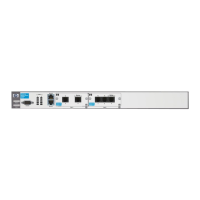B-2
Appendix B: Glossary
AAL Asynchronous Transfer Mode (ATM) Adaptation Layer. The AAL is the
interface between the higher layer protocols and the ATM layer. When relaying
information it receives from the higher layer protocols, the AAL segments the
data into ATM cells. When relaying information it receives from the ATM layer,
the AAL reassembles the payload into a format the higher layers can
understand. This process is called Segmentation and Reassembly (SAR).
Different classes of AAL have been defined to support different types of traffic
or services: AAL1, AAL2, AAL3/4, and AAL5. See also AAL5.
AAL5 ATM Adaptation Layer 5. AAL5 supports services with varying bit rate
demands. It offers low bandwidth overhead and simpler processing require-
ments in exchange for reduced bandwidth capacity and error-recovery
capability. AAL5, is used for IP and WAN applications. See also AAL.
ABM Asynchronous Balance Mode. ABM designates a type of HDLC connection,
where devices at both ends of a connection are configured to be both primary
and secondary devices. Both devices can establish a link, transmit data
without permission, and terminate the link. See also NRM, ARM.
ABR Area Border Router. In an network running the open shortest path first (OSPF)
routing protocol, an ABR is a router in the network backbone that has
interfaces in more than one area. ABRs are responsible for generating a
summary advertisement of the range of networks in a connected stub area, as
well as for distributing summary advertisements for others areas to routers in
the stub area so that these routers can forward inter-area traffic. ABRs
receives traffic from routers in stub areas and routes the traffic through the
network backbone to the destination area.
ACK Acknowledge, one of the Transport Control Protocol (TCP) flags, used by one
peer to acknowledge that it has received a TCP packet from another peer.
ACKs help to maintain TCP’s reliability in initiating, managing, and terminating
sessions. For example, setting TCP packets’ ACK flag is part of the three-way
handshake used to establish a session between a server and a client. Because
TCP requires a peer to receive an acknowledge before continuing the process,
peers can be sure that they have successfully exchanged necessary
information with a legitimate peer.
ACL Access Control List. An ACL selects packets according to values in their IP
headers, including protocol, source and destination IP address, and source
and destination port. Routers compare packets that arrive an interface against
ACLs to determine whether the packet needs special handling. For example,
an ACL applied to a quality of service (QoS) map can select traffic for a low-
latency queue. An ACL can also be used to select traffic for policy-based
routing (PBR), for network address translation (NAT), or for a virtual private
network (VPN) connection.

